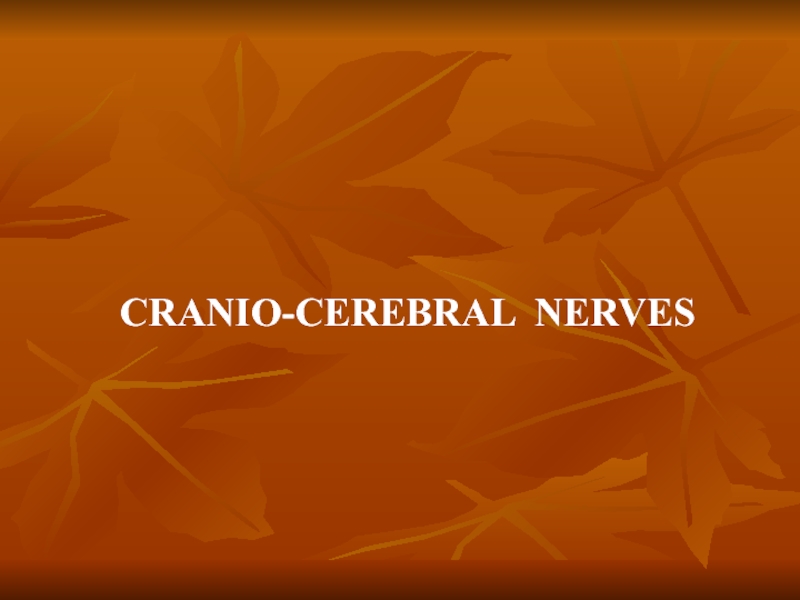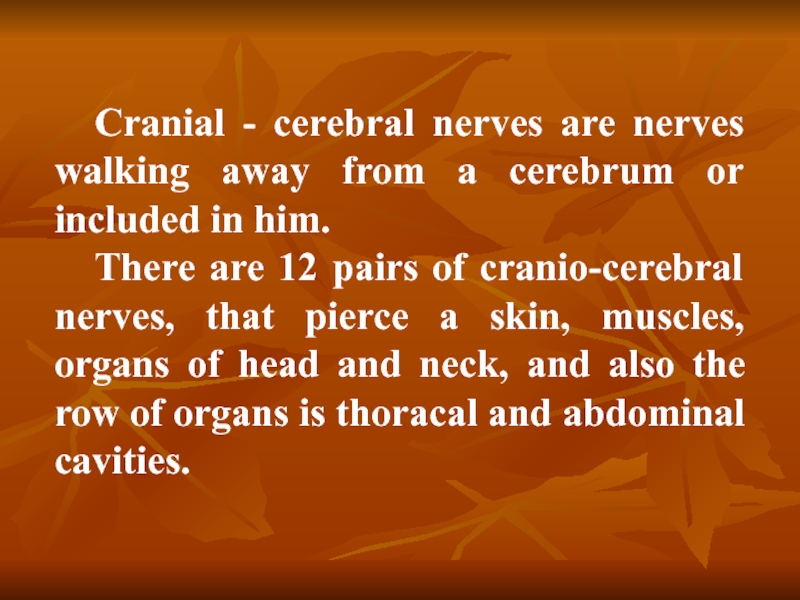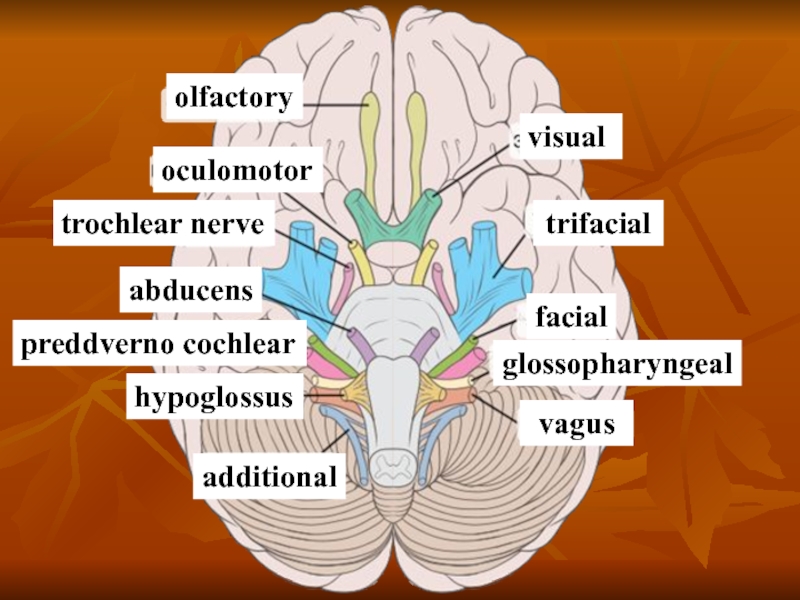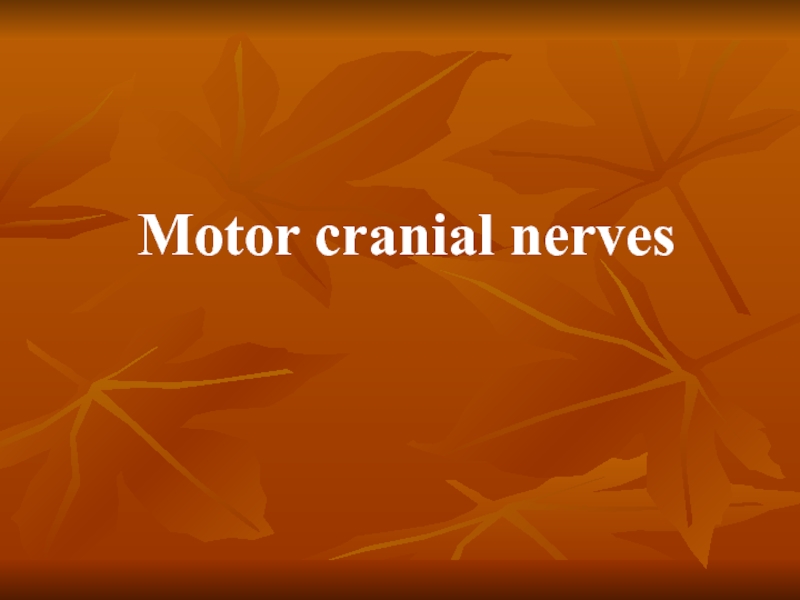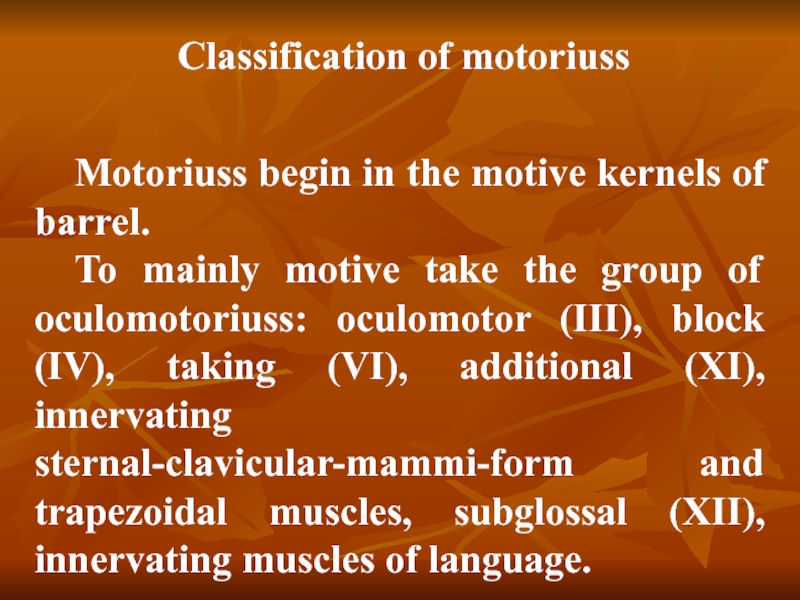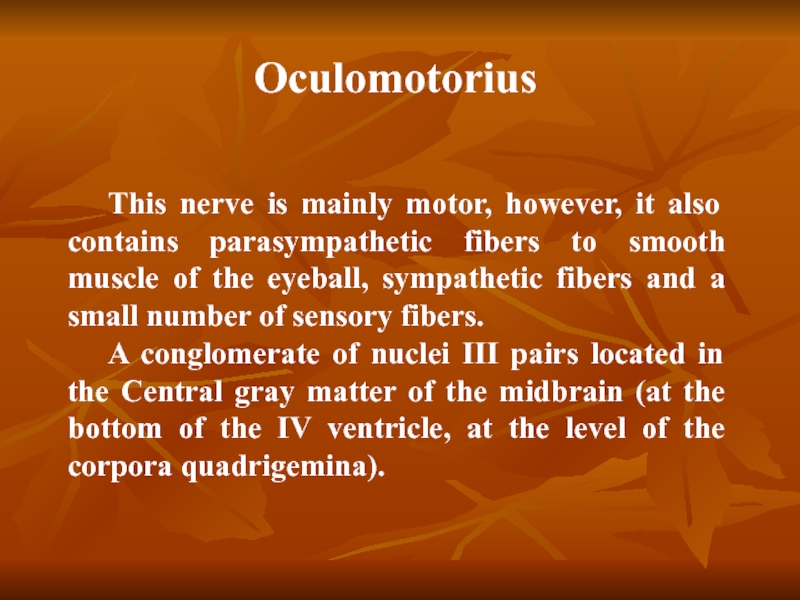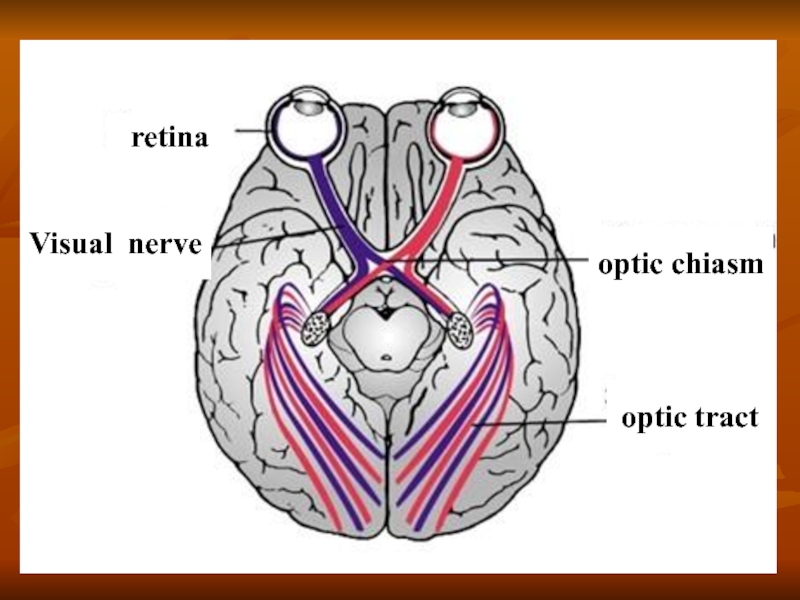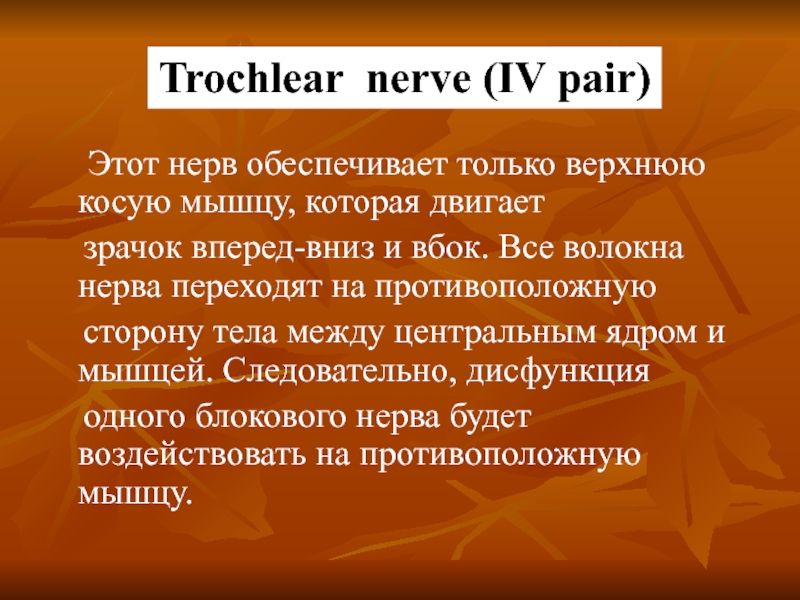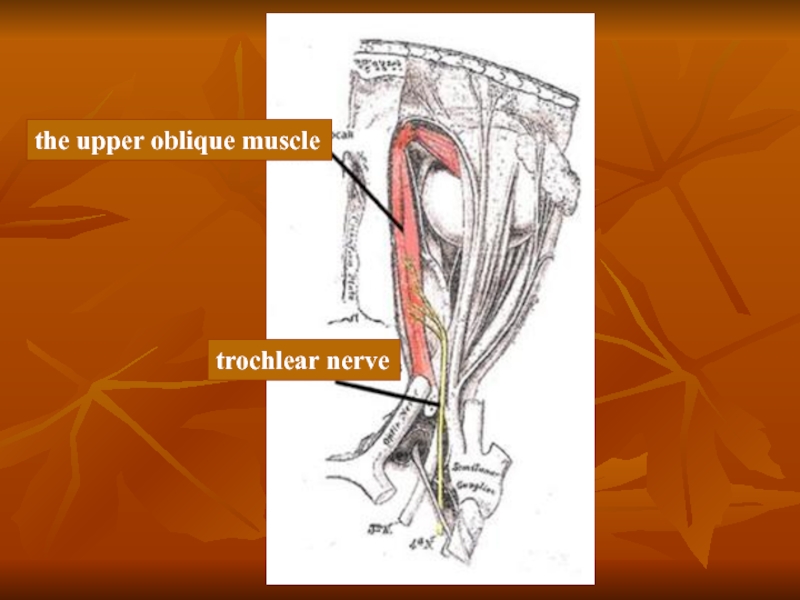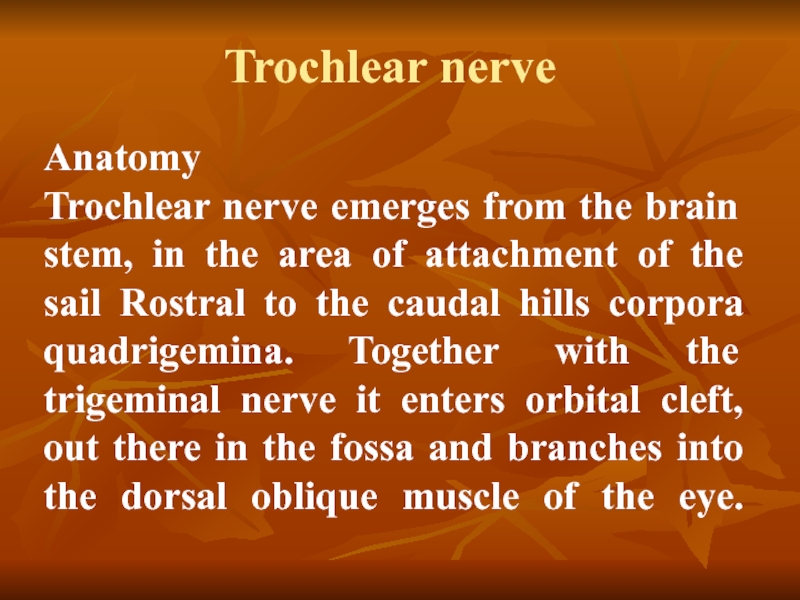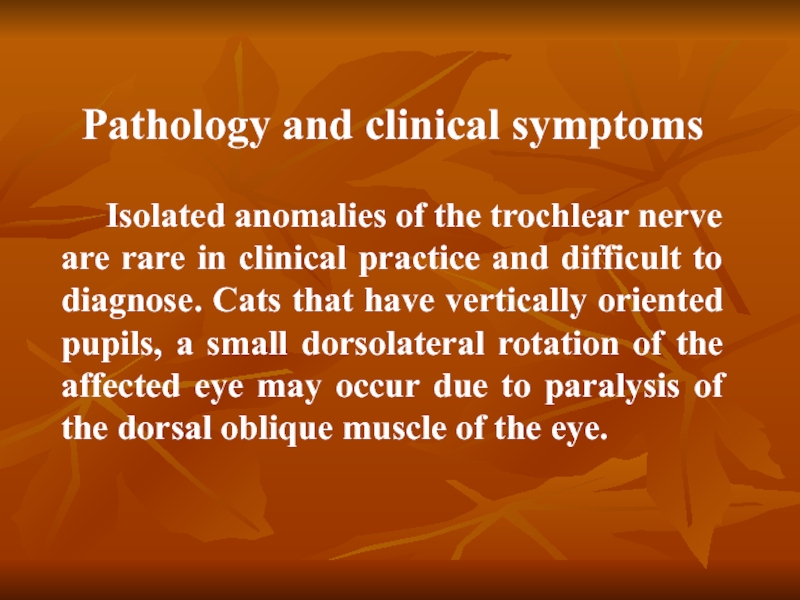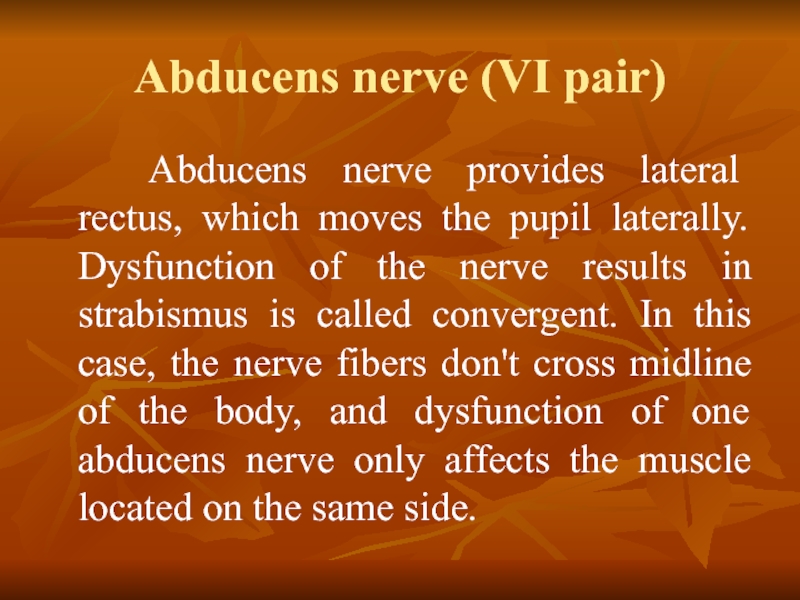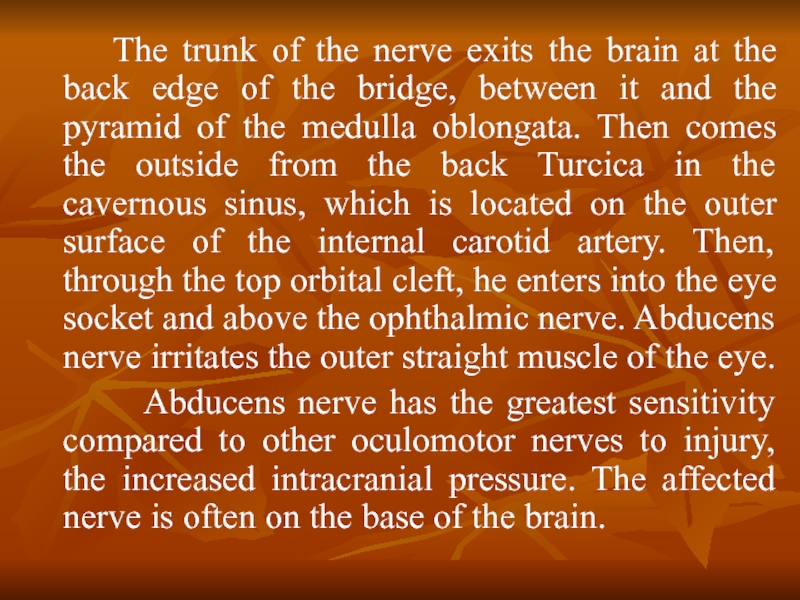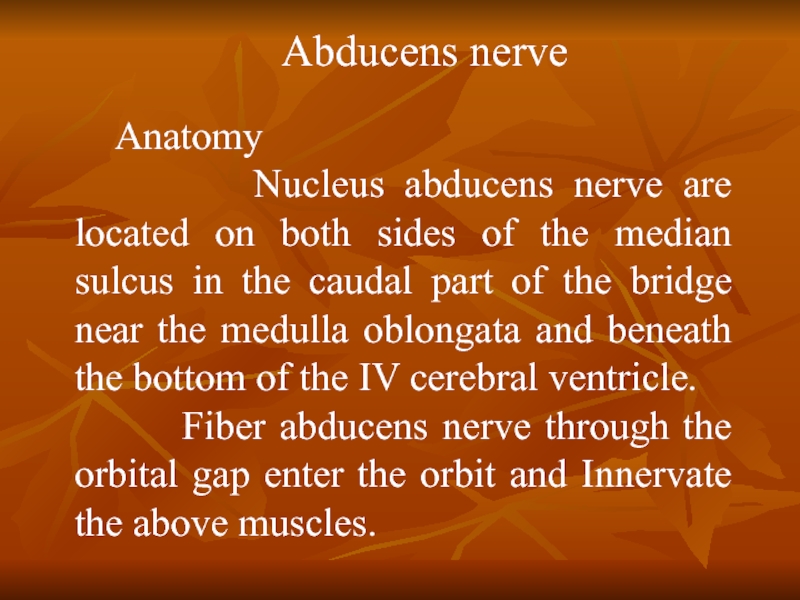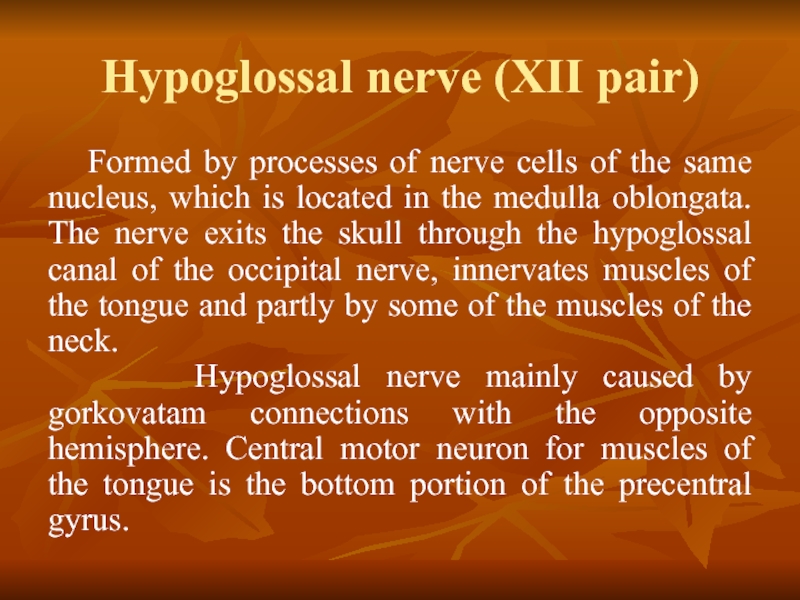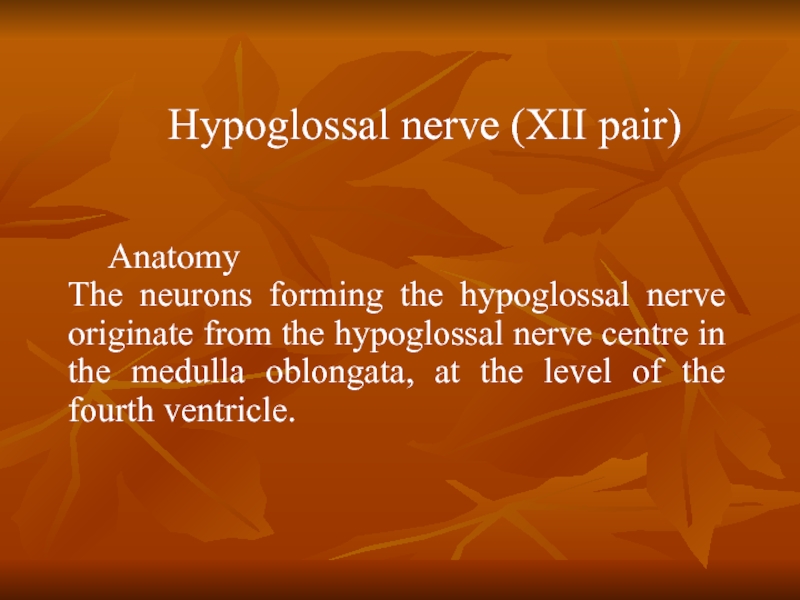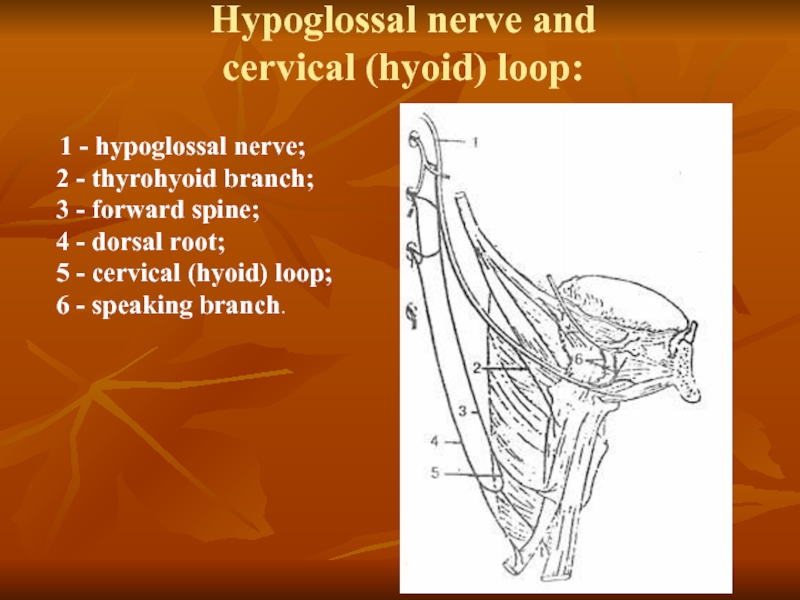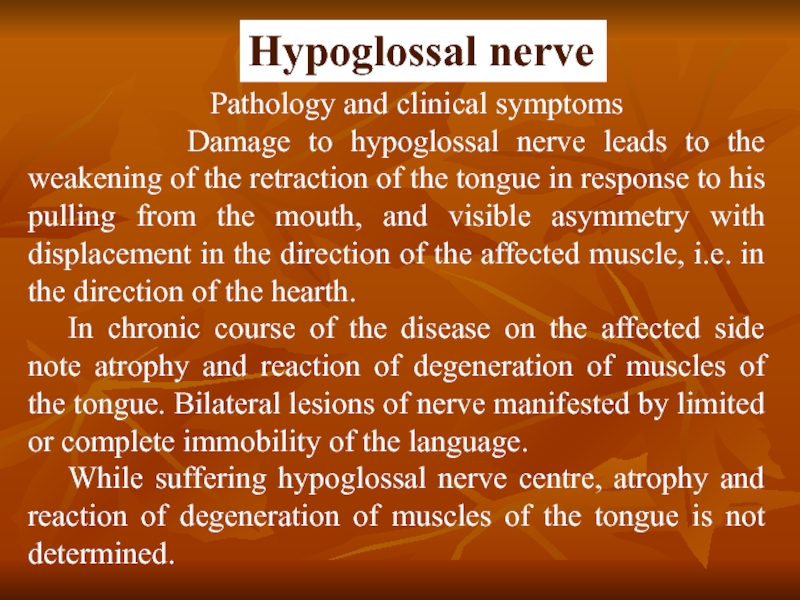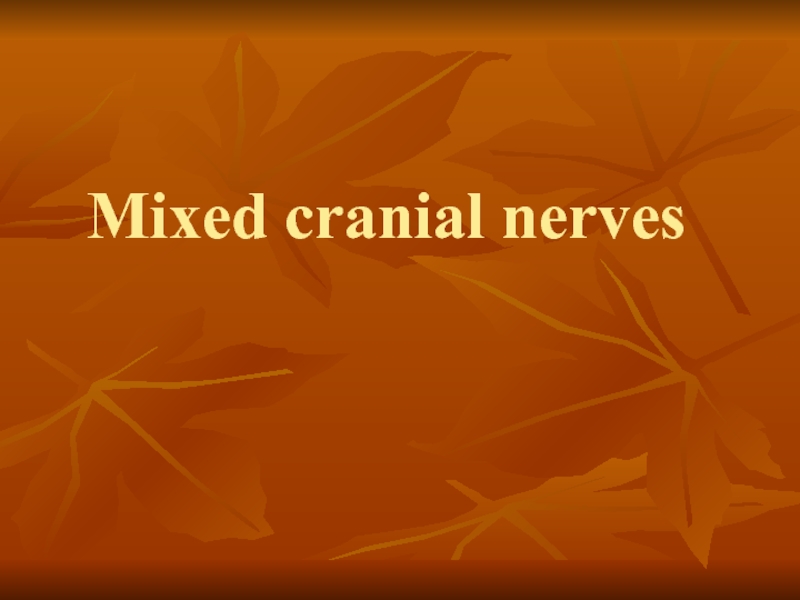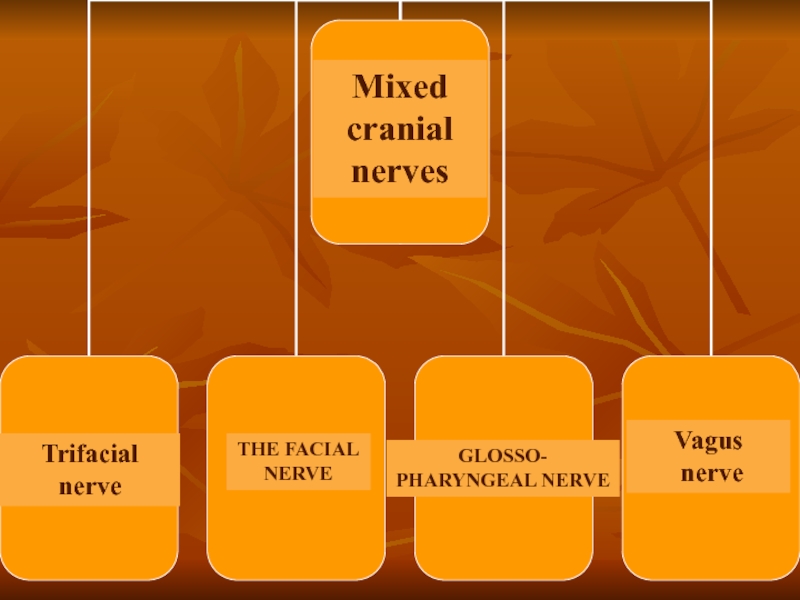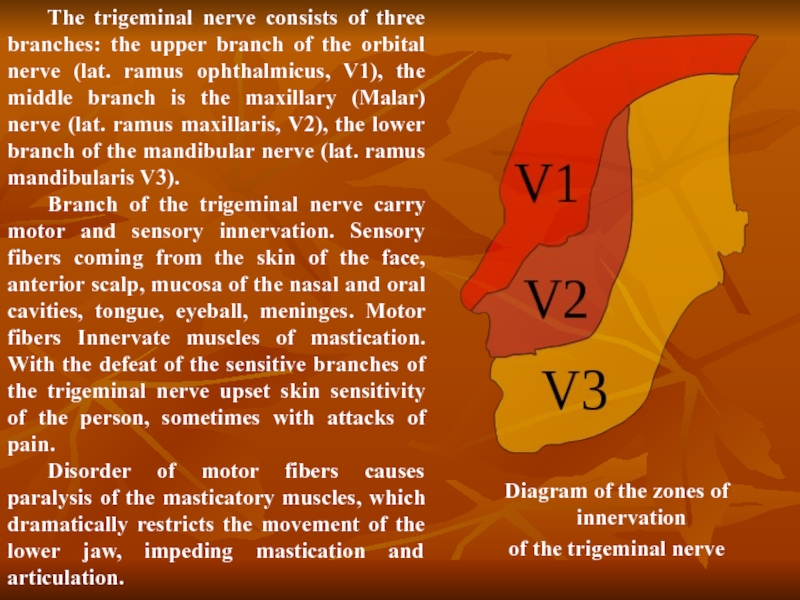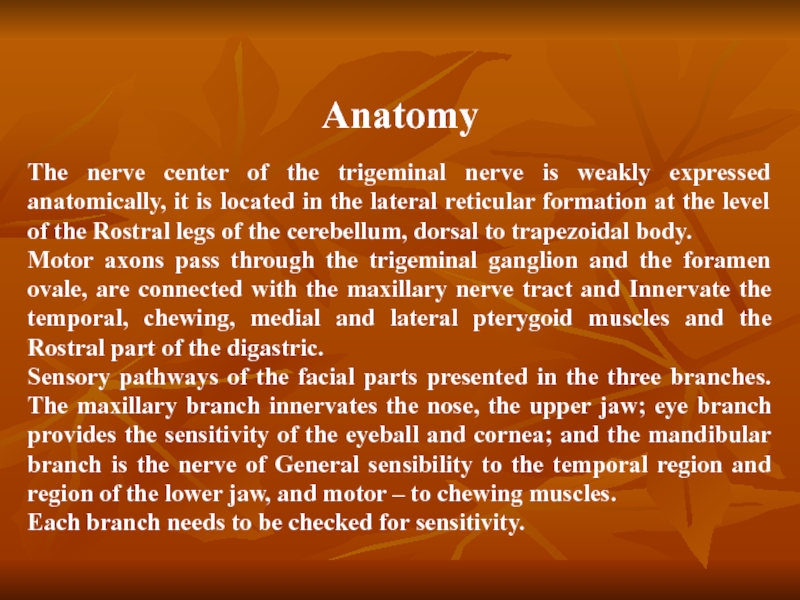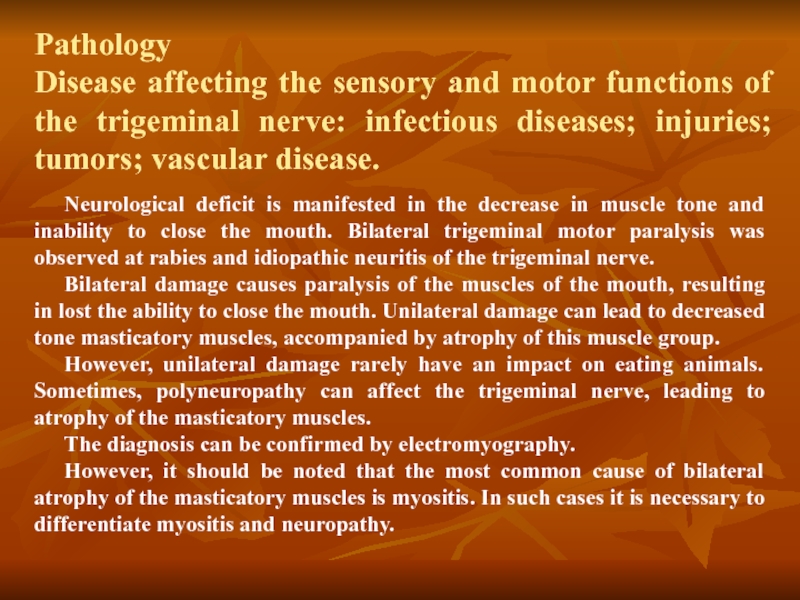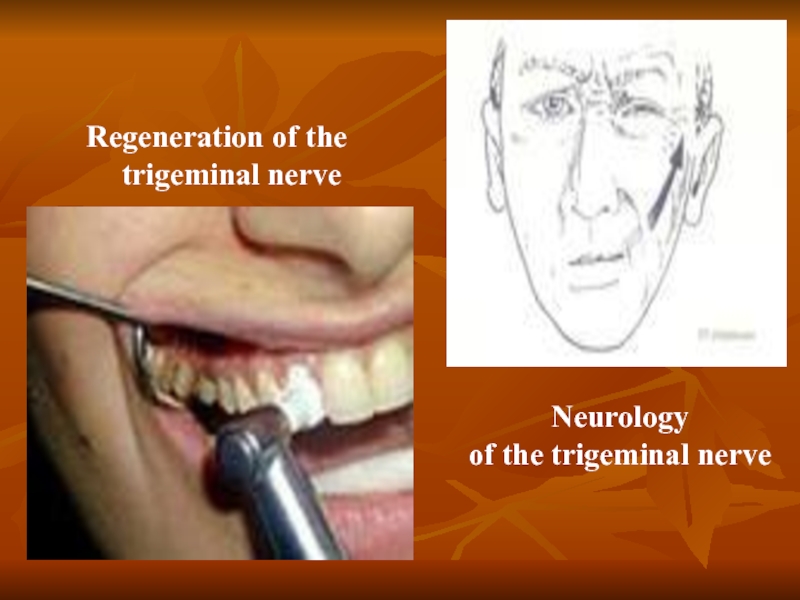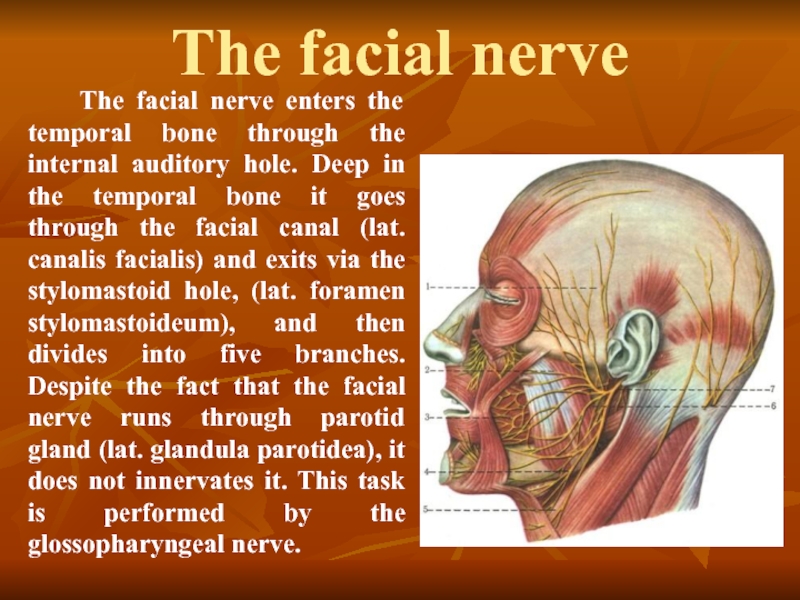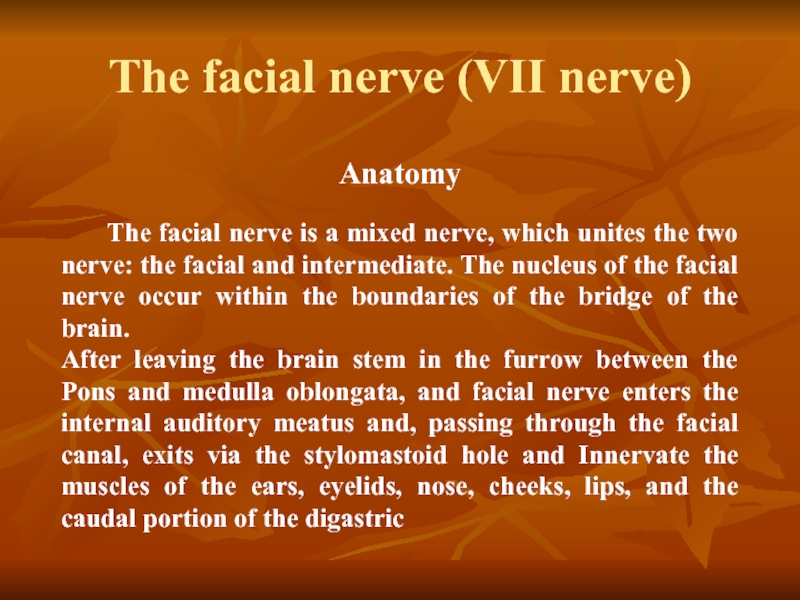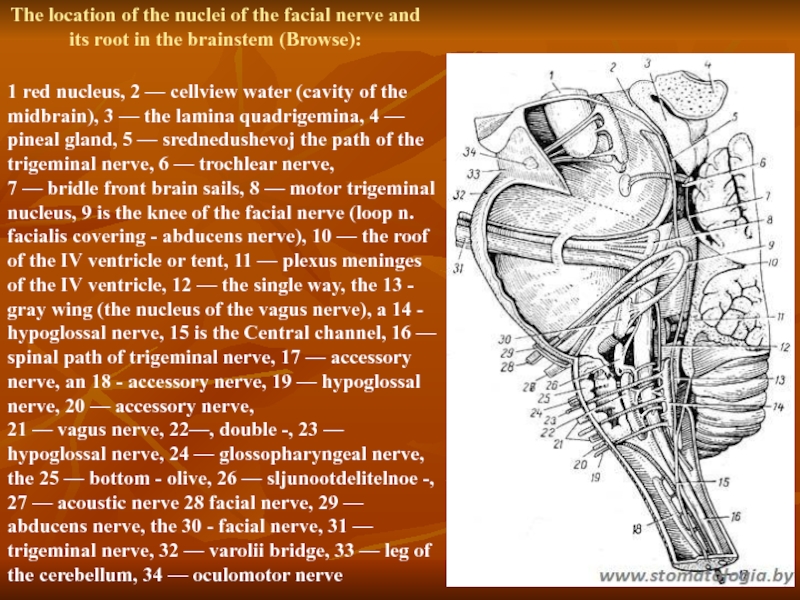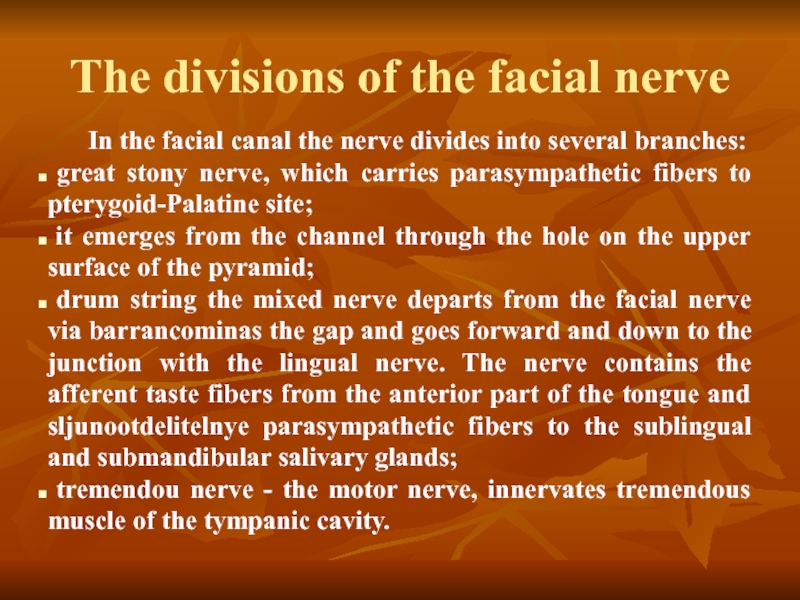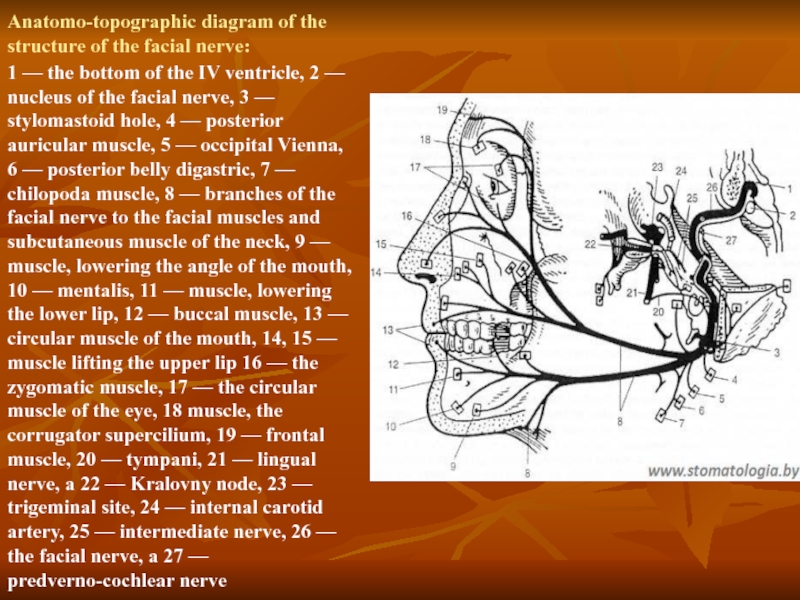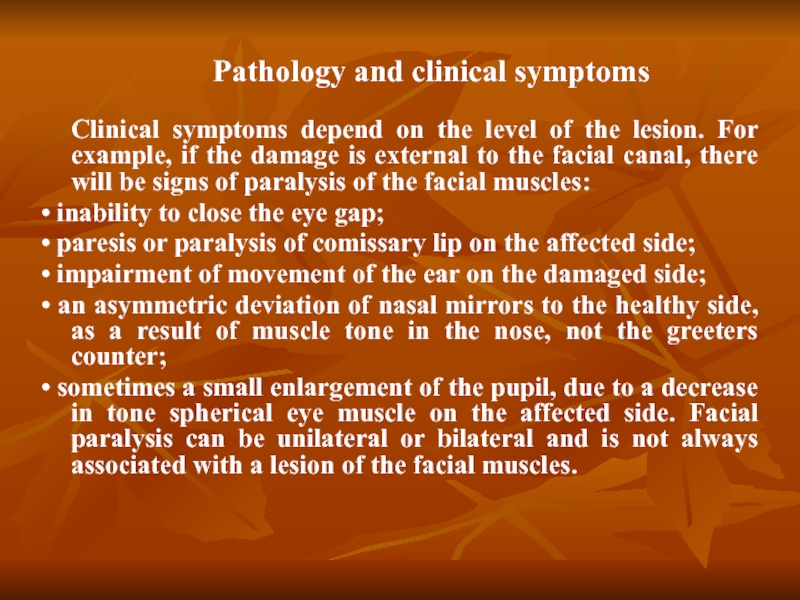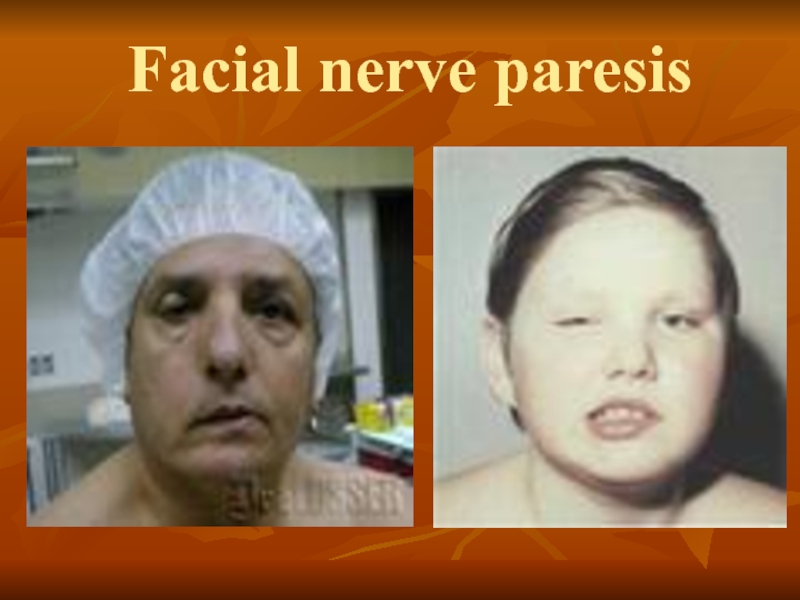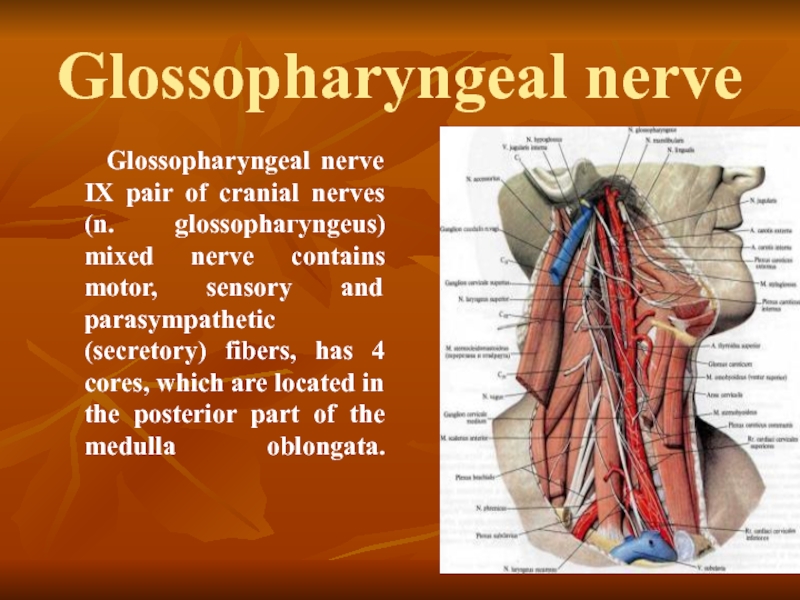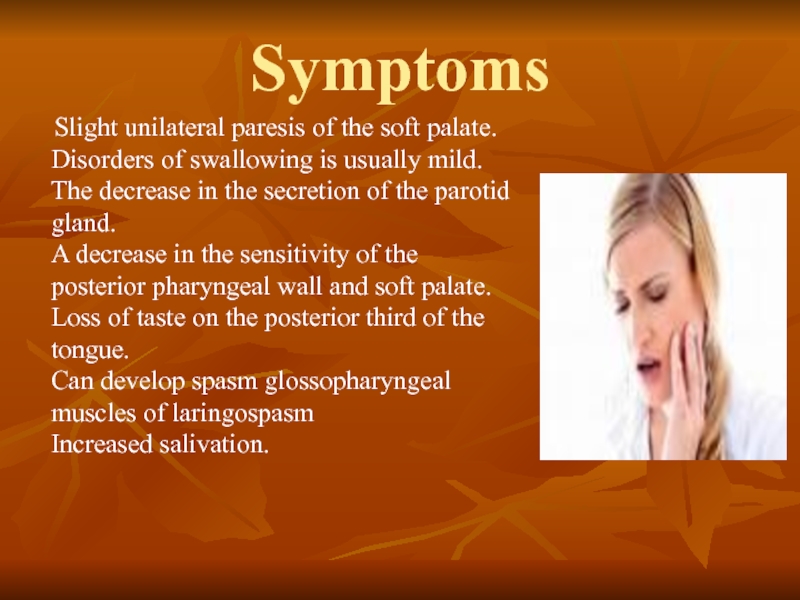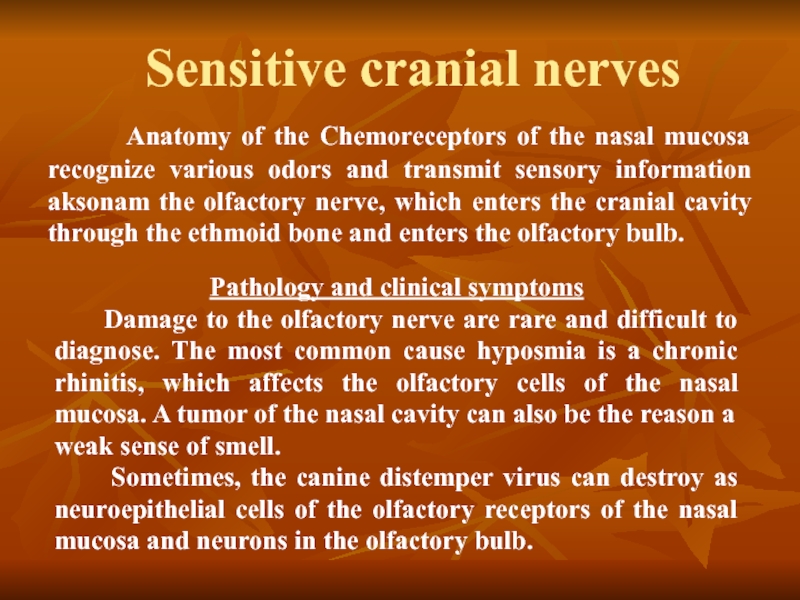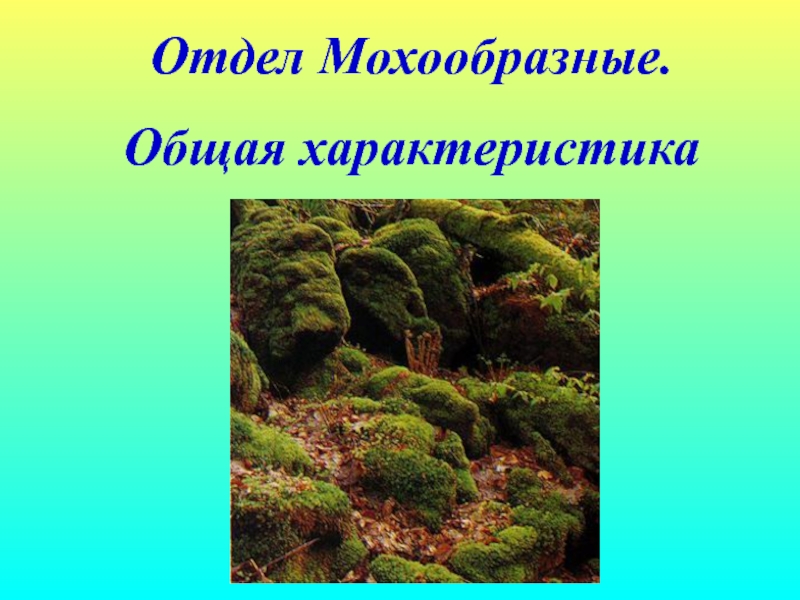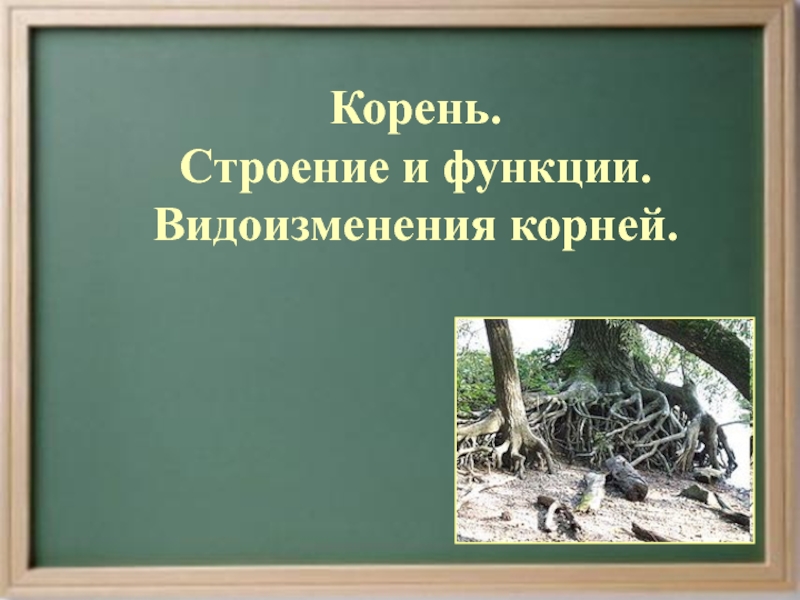- Главная
- Разное
- Дизайн
- Бизнес и предпринимательство
- Аналитика
- Образование
- Развлечения
- Красота и здоровье
- Финансы
- Государство
- Путешествия
- Спорт
- Недвижимость
- Армия
- Графика
- Культурология
- Еда и кулинария
- Лингвистика
- Английский язык
- Астрономия
- Алгебра
- Биология
- География
- Детские презентации
- Информатика
- История
- Литература
- Маркетинг
- Математика
- Медицина
- Менеджмент
- Музыка
- МХК
- Немецкий язык
- ОБЖ
- Обществознание
- Окружающий мир
- Педагогика
- Русский язык
- Технология
- Физика
- Философия
- Химия
- Шаблоны, картинки для презентаций
- Экология
- Экономика
- Юриспруденция
Cranio-cerebral nerves презентация
Содержание
- 1. Cranio-cerebral nerves
- 2. Cranial - cerebral nerves are nerves walking
- 3. Distinguish: motoriuss (III, IV, VI, XI and
- 4. trochlear nerve
- 5. Motor cranial nerves
- 6. Classification of motoriuss Motoriuss begin in the
- 7. Oculomotorius This nerve is mainly motor, however,
- 9. Этот нерв обеспечивает только верхнюю косую мышцу,
- 11. Trochlear nerve Anatomy Trochlear nerve emerges from
- 12. Pathology and clinical symptoms
- 13. Abducens nerve (VI pair) Abducens nerve
- 14. The trunk of the nerve exits
- 15. Anatomy Nucleus
- 16. 1 - abducens nerve 2 - optic
- 17. Hypoglossal nerve (XII pair) Formed by processes
- 18. Anatomy The neurons forming the hypoglossal nerve
- 19. Hypoglossal nerve and cervical (hyoid) loop:
- 20. Hypoglossal nerve Pathology and clinical symptoms
- 21. Mixed cranial nerves
- 22. Mixed cranial nerves THE FACIAL
- 23. Trifacial nerve Trigeminal nerve (from lat.
- 24. The trigeminal nerve consists of three branches:
- 25. Trigeminal nerve Anatomy The nerve center
- 26. Pathology Disease affecting the sensory and
- 27. Regeneration of the trigeminal nerve Neurology of the trigeminal nerve
- 28. The facial nerve The
- 30. The facial nerve (VII nerve) Anatomy
- 31. The location of the nuclei of the
- 32. The divisions of the facial nerve In
- 33. Anatomo-topographic diagram of the structure of the
- 34. Pathology and clinical
- 35. Facial nerve paresis
- 36. Diagnostic methods of neurology facial nerve
- 37. Glossopharyngeal nerve Glossopharyngeal
- 38. Symptoms Slight unilateral paresis
- 39. With the defeat
- 40. Sensitive cranial nerves
- 41. Thank you for your attention!
Слайд 2Cranial - cerebral nerves are nerves walking away from a cerebrum
There are 12 pairs of cranio-cerebral nerves, that pierce a skin, muscles, organs of head and neck, and also the row of organs is thoracal and abdominal cavities.
Слайд 3Distinguish:
motoriuss (III, IV, VI, XI and XII of pair);
mixed nerves
nerves of sense-organs - I and II of pair.
Слайд 6Classification of motoriuss
Motoriuss begin in the motive kernels of barrel.
To
Слайд 7Oculomotorius
This nerve is mainly motor, however, it also contains parasympathetic fibers
A conglomerate of nuclei III pairs located in the Central gray matter of the midbrain (at the bottom of the IV ventricle, at the level of the corpora quadrigemina).
Слайд 9 Этот нерв обеспечивает только верхнюю косую мышцу, которая двигает
зрачок
сторону тела между центральным ядром и мышцей. Следовательно, дисфункция
одного блокового нерва будет воздействовать на противоположную мышцу.
Trochlear nerve (IV pair)
Слайд 11Trochlear nerve
Anatomy
Trochlear nerve emerges from the brain stem, in the area
Слайд 12Pathology and clinical symptoms
Isolated anomalies of the trochlear
Слайд 13Abducens nerve (VI pair)
Abducens nerve provides lateral rectus, which moves
Слайд 14 The trunk of the nerve exits the brain at the
Abducens nerve has the greatest sensitivity compared to other oculomotor nerves to injury, the increased intracranial pressure. The affected nerve is often on the base of the brain.
Слайд 15Anatomy Nucleus abducens nerve are located on
Fiber abducens nerve through the orbital gap enter the orbit and Innervate the above muscles.
Abducens nerve
Слайд 17Hypoglossal nerve (XII pair)
Formed by processes of nerve cells of the
Hypoglossal nerve mainly caused by gorkovatam connections with the opposite hemisphere. Central motor neuron for muscles of the tongue is the bottom portion of the precentral gyrus.
Слайд 18Anatomy The neurons forming the hypoglossal nerve originate from the hypoglossal nerve
Hypoglossal nerve (XII pair)
Слайд 19Hypoglossal nerve and
cervical (hyoid) loop:
1 - hypoglossal
Слайд 20Hypoglossal nerve
Pathology and clinical symptoms
Damage to hypoglossal
In chronic course of the disease on the affected side note atrophy and reaction of degeneration of muscles of the tongue. Bilateral lesions of nerve manifested by limited or complete immobility of the language.
While suffering hypoglossal nerve centre, atrophy and reaction of degeneration of muscles of the tongue is not determined.
Слайд 23Trifacial nerve
Trigeminal nerve
(from lat. nervus trigeminus)
V pair
of cranial nerves
Ternary nerve (shown in yellow)
Слайд 24The trigeminal nerve consists of three branches: the upper branch of
Branch of the trigeminal nerve carry motor and sensory innervation. Sensory fibers coming from the skin of the face, anterior scalp, mucosa of the nasal and oral cavities, tongue, eyeball, meninges. Motor fibers Innervate muscles of mastication. With the defeat of the sensitive branches of the trigeminal nerve upset skin sensitivity of the person, sometimes with attacks of pain.
Disorder of motor fibers causes paralysis of the masticatory muscles, which dramatically restricts the movement of the lower jaw, impeding mastication and articulation.
Diagram of the zones of innervation
of the trigeminal nerve
Слайд 25Trigeminal nerve
Anatomy
The nerve center of the trigeminal nerve is weakly expressed
Motor axons pass through the trigeminal ganglion and the foramen ovale, are connected with the maxillary nerve tract and Innervate the temporal, chewing, medial and lateral pterygoid muscles and the Rostral part of the digastric.
Sensory pathways of the facial parts presented in the three branches. The maxillary branch innervates the nose, the upper jaw; eye branch provides the sensitivity of the eyeball and cornea; and the mandibular branch is the nerve of General sensibility to the temporal region and region of the lower jaw, and motor – to chewing muscles.
Each branch needs to be checked for sensitivity.
Слайд 26Pathology Disease affecting the sensory and motor functions of the trigeminal
Neurological deficit is manifested in the decrease in muscle tone and inability to close the mouth. Bilateral trigeminal motor paralysis was observed at rabies and idiopathic neuritis of the trigeminal nerve.
Bilateral damage causes paralysis of the muscles of the mouth, resulting in lost the ability to close the mouth. Unilateral damage can lead to decreased tone masticatory muscles, accompanied by atrophy of this muscle group.
However, unilateral damage rarely have an impact on eating animals. Sometimes, polyneuropathy can affect the trigeminal nerve, leading to atrophy of the masticatory muscles.
The diagnosis can be confirmed by electromyography.
However, it should be noted that the most common cause of bilateral atrophy of the masticatory muscles is myositis. In such cases it is necessary to differentiate myositis and neuropathy.
Слайд 28The facial nerve
The facial nerve enters the temporal
Слайд 30The facial nerve (VII nerve)
Anatomy
The facial nerve
After leaving the brain stem in the furrow between the Pons and medulla oblongata, and facial nerve enters the internal auditory meatus and, passing through the facial canal, exits via the stylomastoid hole and Innervate the muscles of the ears, eyelids, nose, cheeks, lips, and the caudal portion of the digastric
Слайд 31The location of the nuclei of the facial nerve and its
1 red nucleus, 2 — cellview water (cavity of the midbrain), 3 — the lamina quadrigemina, 4 — pineal gland, 5 — srednedushevoj the path of the trigeminal nerve, 6 — trochlear nerve,
7 — bridle front brain sails, 8 — motor trigeminal nucleus, 9 is the knee of the facial nerve (loop n. facialis covering - abducens nerve), 10 — the roof of the IV ventricle or tent, 11 — plexus meninges of the IV ventricle, 12 — the single way, the 13 - gray wing (the nucleus of the vagus nerve), a 14 - hypoglossal nerve, 15 is the Central channel, 16 — spinal path of trigeminal nerve, 17 — accessory nerve, an 18 - accessory nerve, 19 — hypoglossal nerve, 20 — accessory nerve,
21 — vagus nerve, 22—, double -, 23 — hypoglossal nerve, 24 — glossopharyngeal nerve, the 25 — bottom - olive, 26 — sljunootdelitelnoe -, 27 — acoustic nerve 28 facial nerve, 29 — abducens nerve, the 30 - facial nerve, 31 — trigeminal nerve, 32 — varolii bridge, 33 — leg of the cerebellum, 34 — oculomotor nerve
Слайд 32The divisions of the facial nerve
In the facial canal the nerve
great stony nerve, which carries parasympathetic fibers to pterygoid-Palatine site;
it emerges from the channel through the hole on the upper surface of the pyramid;
drum string the mixed nerve departs from the facial nerve via barrancominas the gap and goes forward and down to the junction with the lingual nerve. The nerve contains the afferent taste fibers from the anterior part of the tongue and sljunootdelitelnye parasympathetic fibers to the sublingual and submandibular salivary glands;
tremendou nerve - the motor nerve, innervates tremendous muscle of the tympanic cavity.
Слайд 33Anatomo-topographic diagram of the structure of the facial nerve:
1 — the
Слайд 34 Pathology and clinical symptoms
Clinical symptoms depend on
• inability to close the eye gap;
• paresis or paralysis of comissary lip on the affected side;
• impairment of movement of the ear on the damaged side;
• an asymmetric deviation of nasal mirrors to the healthy side, as a result of muscle tone in the nose, not the greeters counter;
• sometimes a small enlargement of the pupil, due to a decrease in tone spherical eye muscle on the affected side. Facial paralysis can be unilateral or bilateral and is not always associated with a lesion of the facial muscles.
Слайд 36Diagnostic methods of neurology facial nerve
Clinical neurological examination
Instrumental methods
Electromyography
Doppler
CT scan of the brain
MRI of the brain
Слайд 37Glossopharyngeal nerve
Glossopharyngeal nerve IX pair of cranial
Слайд 38Symptoms
Slight unilateral paresis of the soft palate.
Disorders
Слайд 39 With the defeat of motor nuclei of
Слайд 40 Sensitive cranial nerves
Anatomy of the Chemoreceptors of
Pathology and clinical symptoms
Damage to the olfactory nerve are rare and difficult to diagnose. The most common cause hyposmia is a chronic rhinitis, which affects the olfactory cells of the nasal mucosa. A tumor of the nasal cavity can also be the reason a weak sense of smell.
Sometimes, the canine distemper virus can destroy as neuroepithelial cells of the olfactory receptors of the nasal mucosa and neurons in the olfactory bulb.
